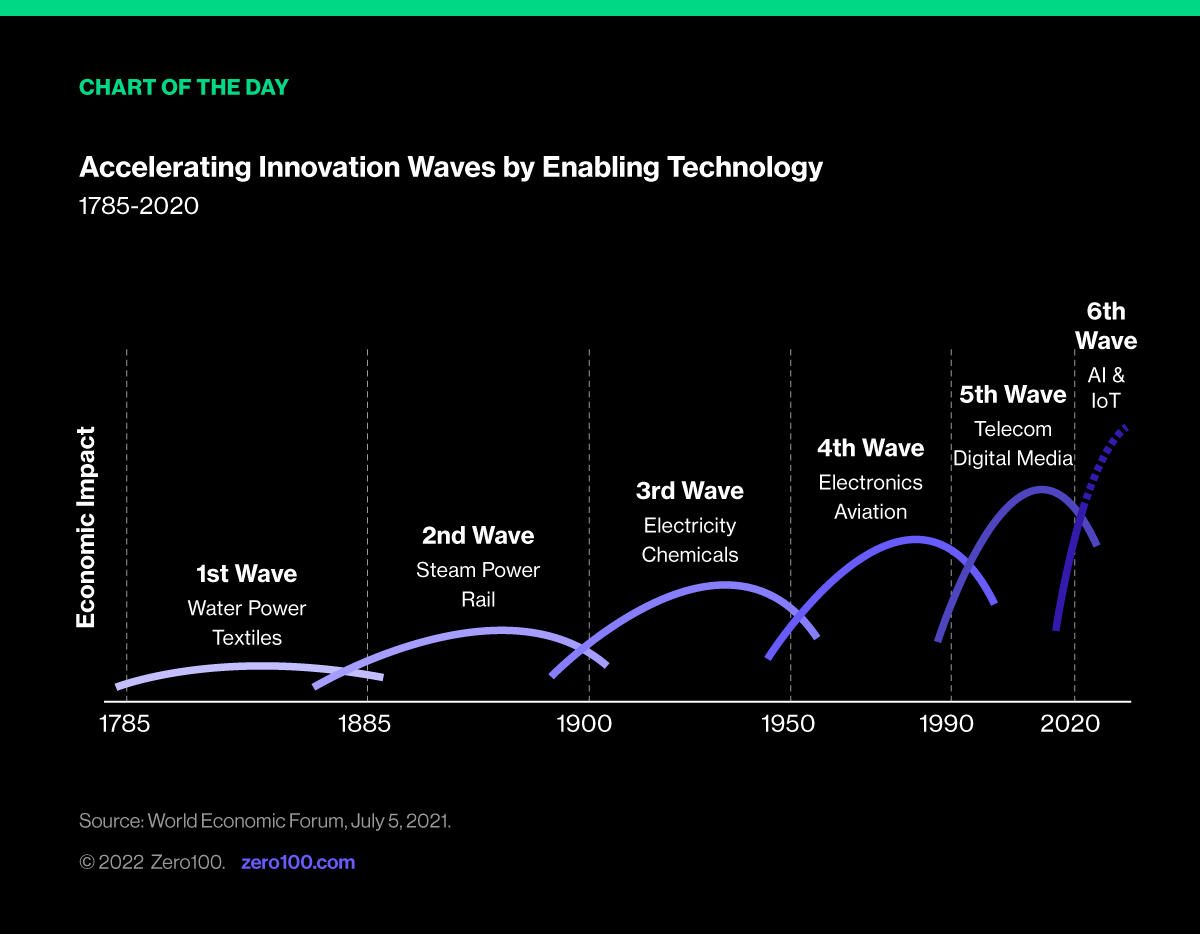For Innovation, Timing is Everything
Airlines have had a tough go lately, between weather (climate change), staff (uh, global pandemic), and technology transitions (5G expansion). In the mainstream media, the risks from 5G expansion seemed to rear its head at the 11th hour.
This gets me thinking.
Technology is hard. We set off on our grand digital adventures but often, we quickly find ourselves in those... “wow, well... it depends, I guess” moments. Simple use cases devolve into layers of misshapen onions and our ambitious plans are descoped due to “unforeseen complexities.” And this is for technology that we already KNOW works.
New tech is the real zinger, and new tech comes in waves. Lucky for us, we're in an upward swing of one of those waves right now.
Waves of Innovation
The first innovation wave in our story today started in 1760 with the first Industrial Revolution and has repeated every 50-60 years since then. These waves include upward swings, downward swings, and transition phases.
The upward swings are where innovation happens. This is the time to double down on what we're doing and throw the power of technology into moving society forward. Disruption is high and favors innovators; companies that focus on efficiency typically get displaced.
But focus on efficiency is a winning strategy for the downward swings where entrepreneurs are out and hedge funds are in. Discoveries and innovation happen in downward swings, too, but only as smaller ideas. Scale happens during upward swings.

Riding the Innovation Wave
The wave we're riding now started in 2008 and is predicted to last until 2040. If the peak of the upward swing falls more or less in the middle of a wave, then our upward swing ends around 2025 followed by a downward swing that will last until 2040... which means we've got some serious work to do right now.
To properly ride this wave of innovation, we'll continue to invest – a lot. The level of investment needed to address the carbon challenge seems to be a widely varying number, landing somewhere between $9 trillion and $100 trillion. This week, we see a number of companies aiming to ride the innovation wave.
Shorter Supply Chains: 3D printing in regional factories seems like a good idea. But it raises skepticism based on a flawed assumption: that the future looks a lot like today, just shifted geographically – that it's a pipe dream to assume that millions of factories workers from Asia can be magically recreated in geographies closer to users. Yes AND - this misses the point, that new tech is often about reimagining production and distribution into a model that doesn't look like the mega factories of today.
Regeneration: Carbon capture works by attracting and heating CO2 from the air. It's super cool to take carbon out of the air, but less cool that it's very energy intensive. MIT spinoff Verdox caught the news this week for gathering $80 million from investors to apply a new method that can save 70% of the energy this technology takes today. Watch this space, folks – regeneration is hot hot hot.
Change the Packaging: this week, HP acquired paper bottle company Choose, in a bid to avoid plastic packaging and tackle the $10 billion fiber-based packaging market that spans industries. Imagine if that fiber comes from a regenerative source and is regionally produced - and we may have a plan in the making.
As a Community, We Win
If history plays out and we are nearing the peak of this 6th wave of innovation, let's rally around this timeline:
- Today we gather all innovative brains and throw everything we have at the carbon problem.
- Around 2025 we'll start to stagnate and enter the downward swing where the baton will be handed from innovation to efficiency
- 2030 our planet will NOT be 1.5*C warmer, because we'll have succeeded in our joint mission.
- Somewhere around 2040 investment will pick up again, we'll be back to innovation.
This vision is only possible if we work together. Community plays a critical role in our acceleration of innovation while we're still in this upswing.
Let's not miss this window.
Critical Reading
THE BOOK STORE
Transition Point: From Steam to the Singularity
Commentary: For more on innovation cycles and the history of innovation, check out Sean Culey's excellent book Transition Point: From Steam to the Singularity.
#innovation #history
TIME
The Great Resignation Fueled Higher Pay – Even For Those Who Didn't Switch Jobs
Commentary: This year's upwards-trending payroll numbers are more a reflection of a tight labor market than an increased cost of living. Companies are going head-to-head in the competition to attract and retain talent.
#talent #labor
THE WALL STREET JOURNAL
Procter & Gamble Uses Its Size to Lessen Impact of Supply-Chain Mess
Commentary: In an effort to help shippers meet the rise in e-commerce demand, FedEx and Microsoft have teamed up in their commitment to produce logistics solutions through the use of data and AI.
#AI #tech #logistics
